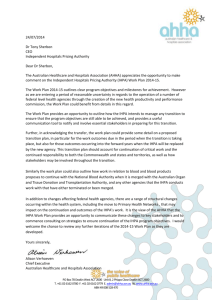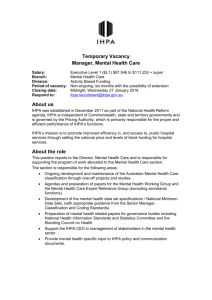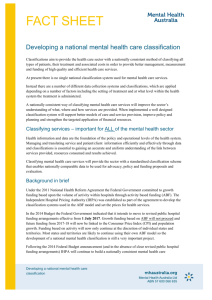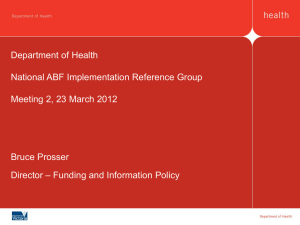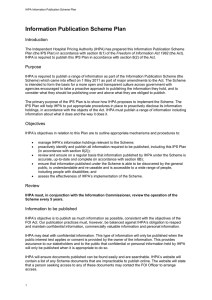Bruce Prosser - 13 February 2012
advertisement
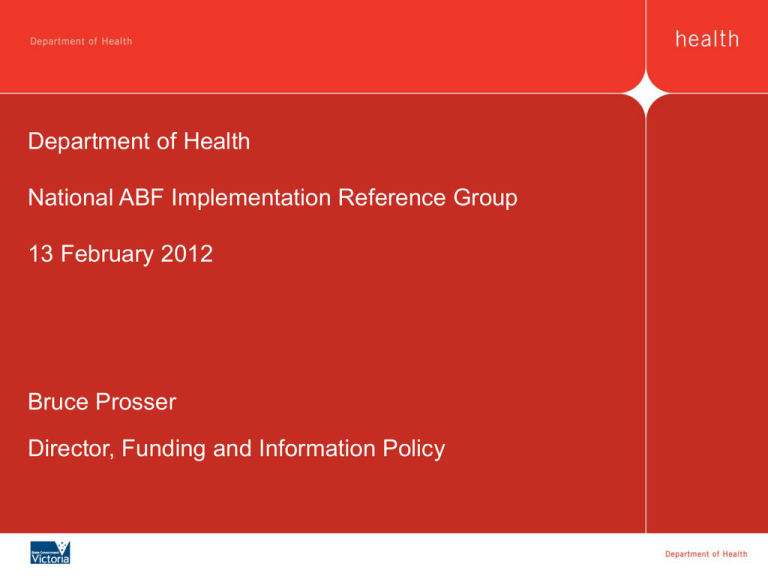
Department of Health National ABF Implementation Reference Group 13 February 2012 Bruce Prosser Director, Funding and Information Policy Welcome Welcome • Purpose of meeting – – – A ‘sounding board’ to test impacts of ABF implementation. DH to provide context on specific topics, pose a series of questions for discussion within the group (hence small group size). Discussions will inform prioritisation of issues to be raised with the IHPA and Commonwealth, policy development, implementation decisions. Meeting topics • Overview of National Health Reform Agreement • Key issues and tasks to be resolved pre 1 July 2012 – – – – IHPA pricing model – high level and technical elements Block funding Funding distribution impact mitigation Scope of services • Costing, data collection and reporting • Date of next meeting and general questions Overview of the National Health Reform Agreement Overview of the National Health Reform Agreement Commonwealth and State Funding Components • Commonwealth Component – – – • IHPA sets National Efficient Price (NEP), national cost weights. Commonwealth pays a percentage of the NEP, back-calculated based on their existing SPP funding pool. Some block funding (composition TBC). State Component – – Price element, specified grant element, transitional funding element. Relativity between elements to be determined, depending on outcome of distribution of Commonwealth contribution. IHPA Pricing Model – high level pricing framework Issue Draft Pricing Framework Victoria response Care Settings Unit of Measure Single Multiple Price Median Based on mean costs in short term Cost of small capital Excluded from price Should be included in price Use of loadings Determined by IHPA State responsibility IHPA Pricing Model – high level pricing framework Issue Draft Pricing Framework Victoria response Private Patients Price discounted for costs funded from other sources Agree with discounting, noting need for incentives and requirement to cover all costs, including administrative Scope of services Public hospital location Should be driven by type of service rather than location Block funding Technical requirements for ABF not met, absence of economies of scale. Definition should be expanded to include other legitimate costs IHPA Pricing Model – high level pricing framework Issue Draft Pricing Framework Victoria response Indexation of costs GFCE – Hospital and Nursing home deflator CPI+ index for three years, then reassess rate Other Victorian Issues Transitional funding Policy role of IHPA IHPA Pricing Model – technical aspects Technical model specification • Deals with detailed model parameters such as outlier payment methodology, ICU copayments. • Stark differences in the ability of service stream pricing models to explain costs, ranging from reasonable for acute admitted, to passable for emergency department, to nonexistent for outpatients. • Continuous feedback being provided on various model iterations via Technical Advisory Committee. IHPA Pricing Model Next steps for the pricing model • The March 30th deliverables from IHPA to governments are expected to include: – – • the draft NEP determination; the Pricing Model with details of the cost and volume specifications used (this will be an Appendix to the Determination); and – the draft Pricing Framework. 45 Days for governments to review. IHPA Pricing Model Questions for participants • Which issues are the most significant – which ones should Victoria prosecute our position the hardest? • What changes in practice may occur if IHPA adopt the Draft Pricing Framework in totality? Block Funding Process and approach • In year 1, the breakdown of the Commonwealth SPP (a fixed pool of money) between ABF and block funding will be determined through a bilateral negotiation. Commonwealth view is that minimal specified grants are justifiable, Victoria’s proportion of funding for Mental Health and Subacute (block funded in 2012-13) is too high. • Proposed approach: develop position on proposed list of specified grants to be retained, ensure they are consistent with IHPA’s draft criteria (which will apply from year 2 onwards), and additional criteria proposed by Victoria: – – Forward-looking costs Financial risk mitigation – transitional block payments Block Funding Questions for participants • Is it easier to manage Health Services if a greater proportion of funding is provided as a specified grant rather than funding via price? Funding distribution impacts Funding distribution impacts • Combined impact of: – – – – cost weights calculated using national rather than just Victorian data; modified ‘WIES’ model for acute admitted; new ABF funding model for ED and outpatients; and reduced number of specified grants will have significant impact on funding distribution across Health Services if Victoria were to strictly replicate IHPA funding model. • Modelling is underway to determine impacts at Health Service level, and options to structure state funding contribution to mitigate financial risk to Health Services. Funding distribution impacts Funding distribution impacts – questions for participants • Given combined impact of changes, how should the State contribution be structured to mitigate funding distribution impacts? – – – peer pricing? reduced price based on Commonwealth price? separate state-based price? • Assuming aggregate LHN budgets are maintained, what issues may be generated as a result of ‘clunky’ transitional payments, differences in remittance advices. • Are there any specific programs that will be particularly disadvantaged – e.g. renal, Commonwealth funding unlikely to replicate capitation model, significant ‘rebalancing’. Scope of Services What does the NHRA say? • Clause A10 of NHRA broadly outlines in-scope services to be ABF: – – – – Admitted Acute services, including hospital in the home programs. Emergency Department (ED) services. Non-Admitted patient services. Other Outpatient, Mental Health, Subacute services and other services that could reasonably be considered a public hospital service. Scope of Services Process • Clause A21 of the NHRA outlines that unless bilateral agreement is reached with the Commonwealth on scope of services by 1 May 2012, in-scope services will be determined using the following process: • Scope will automatically include all of Clause A10 (listed above). • States will provide the IHPA with recommendations for other services to be considered not captured under Clause A10. • The IHPA will develop criteria for assessing services for inclusion and will consider each State’s recommendations against these criteria to develop a general list of hospital Key issues and tasks to be resolved pre 1 July 2012 Scope of services – key boundary issues • Agreement provides sufficient high-level guidance, but disagreements are expected around the margins. Victoria considers: – – – • Otherwise in-scope activities such as Mental Health and Subacute services undertaken by non-LHN entities should be included in scope. Alcohol and other Drug (AOD) services should be included in scope (regardless of setting). Community Health Programs should be excluded from scope on the basis that they are analogous to primary health care. Commonwealth considers: – Privately referred non-inpatient activity should be out of scope, consistent with clause A6 of NHRA. Scope of Services Questions for participants • How significantly would Health Services be impacted if nonhospital entities (undertaking equivalent hospital services) are excluded from scope? • If any part of a service funded though MBS is excluded from scope (not qualifying for a Commonwealth funding contribution for any part of the occasion of service), how will this impact Health Services? Costing, Data Collection and Reporting Costing and data collection • The NHRA introduces significant new data collection requirements, already evidenced though this year’s collections but expected to escalate into the future as new service streams come online for ABF. • A post implementation review of the Victorian Cost Data Collection (VCDC) is proposed. This will inform a gap analysis of Health Service requirements to provide this data, in areas including: – assistance with need prioritisation, sequencing; – data storage; – data processing; – personnel. Costing, Data Collection and Reporting Questions for participants • • Can participants readily identify any obvious gaps in: – need prioritisation, sequencing; – data storage; – data processing; or – personnel. Is the VCDC Post Implementation review the best channel for beginning to clearly articulate these gaps? General General questions for participants • What is the level of concern within Health Services on the impact of the NHRA in relation to: – – – • funding levels and breakdown? data burden? other aspects? Should any other stakeholder groups be represented at this forum, given its purpose? Next Meeting Next meeting • Proposed date – – – 4 weeks time - 12 March 2012 Pre release of NEP More concrete options for the likely magnitude and structure of transitional funding arrangements will be available.

